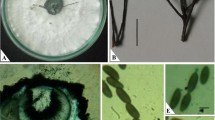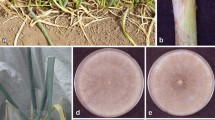Abstract
A new stem rot disease is found to occur naturally on Arabidopsis plants in greenhouses of Fuzhou, China. In order to identify its pathogen, we conducted a series of fungal isolation and purification, plant reinoculation, and ascus and ascospore induction from the sclerotia. The isolate caused typical water-soaked lesions after reinoculation and produced sclerotia both on Arabidopsis plants and culture medium plates, and the sclerotia could be induced to produce discal apothecia and 8 binucleate ascospores per ascus. These disease symptom and fungal morphology data revealed that the fungus Sclerotinia sclerotiorum (Lib.) de Bary was the pathogen for Arabidopsis stem rot. To confirm this, we further amplified its large subunit ribosomal DNA (LSU rDNA) by polymerase chain reaction (PCR), and compared the sequence with the known LSU rDNA sequences in GenBank. The results show that the sequence shares the highest identities with the LSU rDNAs of different S. sclerotiorum strains. Taking all these data together, we concluded that the fungus that caused the Arabidopsis stem rot is S. sclerotiorum (Lib.) de Bary. This is the first report that Arabidopsis is naturally infected by S. sclerotiorum.
Similar content being viewed by others
References
Adams, P.B., Ayers, W.A., 1979. Ecology of Sclerotinia species. Phytopathology, 69(8):896–898.
Bardin, S.D., Huang, H.C., 2001. Research on biology and control of Sclerotinia diseases in Canada. Can. J. Plant Pathol., 23(1):88–98.
Boland, G.J., Webster, S.J., Walker, L., 1994. Index of plant hosts of Sclerotinia sclerotiorum. Can. J. Plant Pathol., 16(2):93–108.
Bolton, M.D., Thomma, B.P.H.J., Nelson, B.D., 2005. Sclerotinia sclerotiorum (Lib.) de Bary: biology and molecular traits of a cosmopolitan pathogen. Mol. Plant Pathol., 7(1):1–16. [doi:10.1111/J.1364-3703.2005.00316.X]
Chet, I., Henis, Y., 1975. Sclerotial morphogenesis in fungi. Annu. Rev. Phytopathol., 13(1):169–192. [doi:10.1146/annurev.py.13.090175.001125]
Christias, C., Lockwood, J.L., 1973. Conservation of mycelial constituents in four sclerotium-forming fungi in nutrient deprived conditions. Phytopathology, 63(5):602–605.
Fang, Z.D., 1998. The Research Method of Plant Pathogenisis, 3rd Ed. China Agriculture Press, Bei**g, p.1–427 (in Chinese).
Kirk, P.M., Cannon, P.F., David, J.C., Stalpers, J.A., 2001. Ainsworth and Bisby’s Dictionary of the Fungi, 9th Ed. CABI Publishing, Wallingford, p.1–655.
Kohn, L.M., 1979. A monographic revision of the genus Sclerotinia. Mycotaxon, 9(2):365–444.
Le Tourneau, D., 1979. Morphology, cytology, and physiology of Sclerotinia species in culture. Phytopathology, 69(8): 887–890.
Long, E.O., Dawid, I.B., 1980. Repeated genes in eukaryotes. Ann. Rev. Biochem., 49(1):727–764. [doi:10.1146/annurev.bi.49.070180.003455]
Lydeard, C., Holznagel, W.E., Schnare, M.N., Gutell, R.R., 2000. Phylogenetic analysis of Molluscan mitochondrial LSU rDNA sequences and secondary structures. Mol. Phylogenet. Evol., 15(1):83–102. [doi:10.1006/mpev.1999.0719]
O’Donnell, K., 1993. Fusarium and its Near Relation. In: Reynolds, D.R., Taylor, J.W. (Eds.), The Fungal Holomorph: Mitotic, Meiotic and Pleomorphic Speciation in Fungal Systematics. CABI Publishing, Wallingford, p.223–233.
Smith, E.A., Boland, G.J., 1989. A reliable method for production of apothecia of Sclerotinia sclerotiorum. Can. J. Plant Pathol., 11(1):45–48.
Sonnenberg, R., Nolte, A.W., Tautz, D., 2007. An evaluation of LSU rDNA D1-D2 sequences for their use in species identification. Front. Zool., 4(1):6. [doi:10.1186/1742-9994-4-6]
Talbot, N.J., Salch, Y.P., Ma, M., Hamer, J.E., 1993. Karyotype variation within clonal lineages of the rice blast fungus, Magnaporthe grisea. Appl. Environ. Microbiol., 59(2):585–593.
Willetts, H.J., Wong, J.A.L., 1980. The biology of Sclerotinia sclerotiorum, S. trifoliorum, and S. minor with emphasis on specific nomenclature. Bot. Rev., 46(2):101–165. [doi:10.1007/BF02860868]
Woese, C.R., Kandler, O., Wheelis, M.L., 1990. Towards a natural system of organisms: Proposal for the domains Archaea, Bacteria, and Eucarya. Proc. Natl. Acad. Sci. USA, 87(12):4576–4579. [doi:10.1073/pnas.87.12.4576]
Author information
Authors and Affiliations
Corresponding authors
Additional information
Project supported by the National Natural Science Foundation of China (No. 30471178) and the Ministry of Agriculture of China (No. nyhyzx07-054)
Rights and permissions
About this article
Cite this article
Wang, Ar., Lin, Ww., Chen, Xt. et al. Isolation and identification of Sclerotinia stem rot causal pathogen in Arabidopsis thaliana . J. Zhejiang Univ. Sci. B 9, 818–822 (2008). https://doi.org/10.1631/jzus.B0860010
Received:
Accepted:
Published:
Issue Date:
DOI: https://doi.org/10.1631/jzus.B0860010
Key words
- Sclerotinia sclerotiorum
- Arabidopsis thaliana
- Large subunit ribosomal DNA (LSU rDNA)
- Systematic classification




